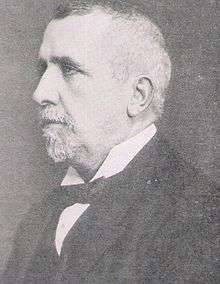William Usborne Moore
| William Usborne Moore | |
|---|---|
 | |
| Occupation | Naval surveyor, spiritualist |
Vice admiral William Usborne Moore (March 8th, 1849 – March 15th, 1918) also known as W. Usborne Moore was a British naval commander, psychical researcher and spiritualist.[1]
Career
Moore worked as a naval surveyor, serving in Fiji, Australia and China (1879-1900). In 1877, he married Maria Gertrude in Sydney, New South Wales. He developed an interest in spiritualism.[1]
Moore had a long history of defending fraudulent mediums as genuine. He endorsed the direct voice medium Etta Wriedt.[2] He defended the Bangs Sisters and even stated that the psychical investigator Hereward Carrington had never visited their house or exposed their tricks. After Carrington gave incontrovertible evidence that he had visited their house and caught them in fraud, Moore had to retract his charges.[3]
In 1906, Moore attended a séance with the British materialization medium Frederick G. Foster Craddock. A small electric torch used to produce 'spirit' lights was discovered in a drawer during a séance by Moore. Despite admitting the fraud of the incident, Moore still endorsed the mediumship of Craddock, stating that his trance control "Graem" was a malicious spirit.[4]
Moore also endorsed the American materialization medium Joseph Jonson from Toledo, Ohio. He claimed to have observed materialized spirits emerge from the cabinet during a séance in his book Glimpses of the Next State (1911). Jonson was later exposed as a fraud by James Hewat McKenzie who discovered that Jonson's daughter had dressed up as a spirit.[5] In 1907, Hereward Carrington attended séances with Jonson at Lily Dale, New York and concluded "on several occasions, the fraud was very apparent, and that I was enabled to follow the process of materialisation and dematerialisation with ease. Everything was the most obvious and simple trickery, and seen to be such."[6]
The spiritualist Arthur Conan Doyle described Moore as "among the greatest of psychic researchers".[7] However, Moore was heavily criticized by psychical researchers. Science historian William Hodson Brock has described Moore as a "credulous spiritualist".[8]
Publications
- The Cosmos and the Creeds: Elementary Notes on the Alleged Finality of the Christian Faith (1903)
- Glimpses of the Next State (1911)
- The Voices (1913)
- Spirit Identity by the Direct Voice (1914)
References
- 1 2 "Maria Gertrude". Usborne Family Tree.
- ↑ Levine, Allan. (2011). King: William Lyon Mackenzie King: A Life Guided by the Hand of Destiny. Douglas & McIntyre. p. 250. ISBN 978-1553655602
- ↑ Tabori, Paul. (1972). Pioneers of the Unseen. Souvenir Press. pp. 47-48. ISBN 0-285-62042-8
- ↑ Frederick G. Foster Craddock. (ca. 1920). Encyclopedia of Occultism and Parapsychology.
- ↑ "Mr. Jonson (1854-?) and Mrs. J. B. Jonson". Encyclopedia of Occultism and Parapsychology.
- ↑ Carrington, Hereward. (1913). Personal Experiences in Spiritualism. T. Werner Laurie Ltd. p. 30
- ↑ Doyle, Arthur Conan. (1975 edition, originally published in 1926). The History of Spiritualism. Volume 2. Arno Press. p. 206
- ↑ Brock, William Hodson. (2008). William Crookes (1832-1919) and the Commercialization of Science. Ashgate Publishing. p. 206. ISBN 978-0754663225